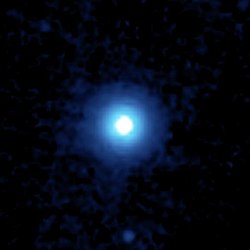
A mid-infrared image of the debris disk around Vega. Spitzer Space Telescope/NASA.
Vega is the brightest star in the constellation Lyra, the fifth brightest star in the night sky and the second brightest star in the northern celestial hemisphere, after Arcturus. It is a relatively nearby star at only 25.3 light years from Earth, and, together with Arcturus and Sirius, one of the most luminous stars in the Sun's neighborhood.
Vega has been extensively studied by astronomers, leading it to be termed, "arguably the next most important star in the sky after the Sun". Historically, Vega served as the pole star at about 12,000 BCE and will do so again at around 14,000 CE. Vega was the first star, other than the Sun, to have its photograph taken and the first to have its spectrum photographed. It was also one of the first stars to have its distance estimated through parallax measurements. Vega has served as the baseline for calibrating the photometric brightness scale, and was one of the stars used to define the mean values for the UBV photometric system.
This star is relatively young when compared to the Sun. It has an unusually low abundance of the elements that have a higher atomic numbers than helium. Vega is also a suspected variable star that may vary slightly in magnitude in a periodic manner. It is rotating rapidly with a velocity of 274 km/s at the equator. This is causing the equator to bulge outward because of centrifugal effects, and, as a result, there is a variation of temperature across the star's photosphere that reaches a maximum at the poles. From the Earth, Vega is being observed from the direction of one of these poles.
Based upon an excess emission of infrared radiation, Vega has a circumstellar disk of dust. This dust is likely the result of collisions between objects in an orbiting debris disk, which is analogous to the Kuiper belt in the Solar System. Stars that display an infrared excess because of dust emission are termed Vega-like stars. Irregularities in Vega's disk also suggest the presence of at least one planet, likely to be about the size of Jupiter, in orbit around Vega.
Hiç yorum yok:
Yorum Gönder